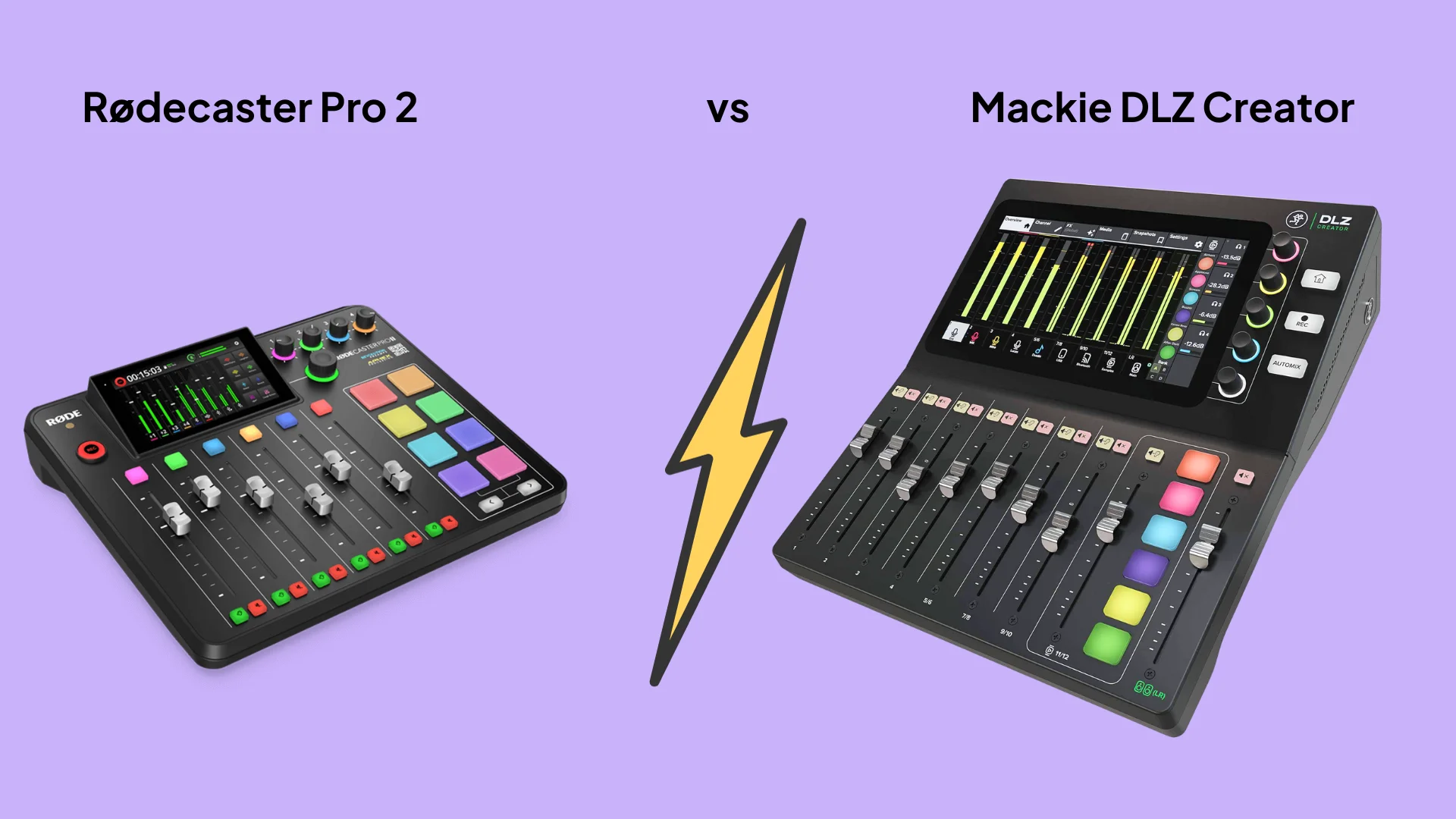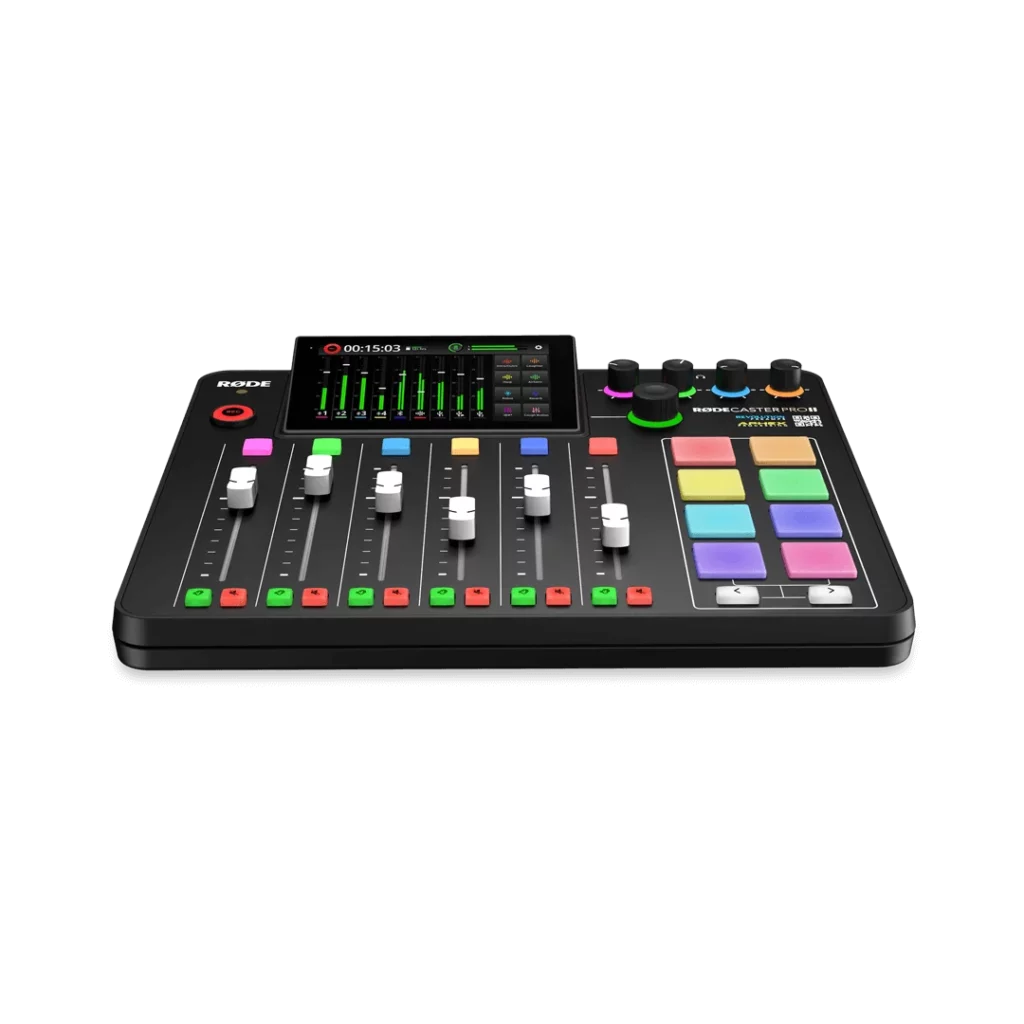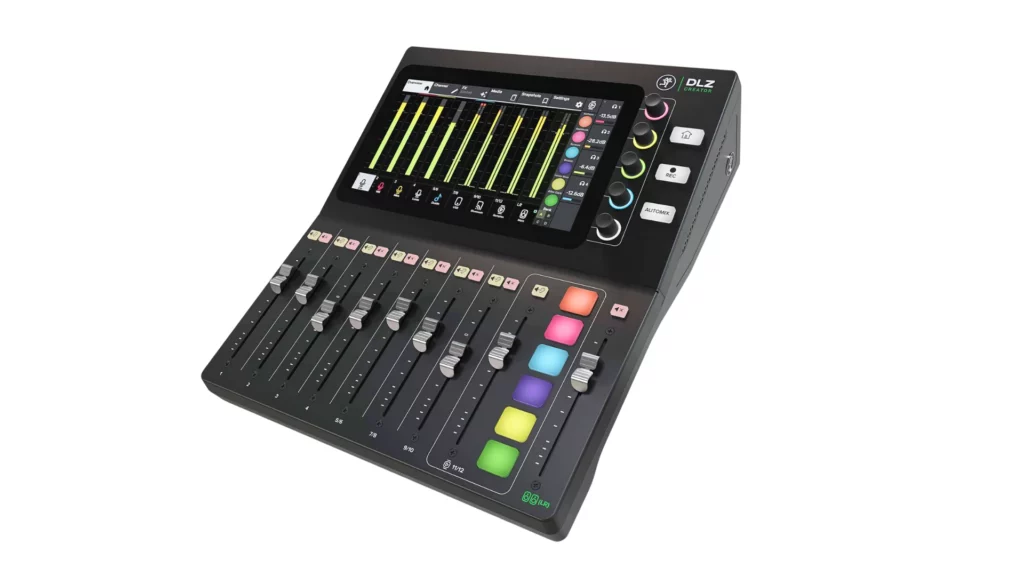Rode Rodecaster Pro 2 vs Mackie DLZ Creator - Who wins the podcasting mixer duel? - Digital recording with a podcast mixer

Rode Rødecaster Pro II - Smart choice for podcasters?

First impression:
The Rødecaster Pro 2* is a compact all-in-one production console for situations with more than one guest. In addition to the smaller version, the Rødecaster Duo with two microphone inputs, the second generation of the Pro has become even more intuitive and is equipped with a clearer interface. The display is reminiscent of a smartphone and is just as self-explanatory to operate.
The connections have not changed much. Just like the first generation, the 4 jack-XLR combo sockets are in the foreground. These are now much more powerful and have even lower noise levels. Otherwise, there are still 4 headphone connections, stereo out for monitors, a Bluetooth interface and 2 USB-C connections. At first glance, the only thing missing is the classic “aux input”, i.e. the 3.5mm jack input. However, the simple Bluetooth function makes this less of a problem.
This stands out positively:
Although the screen is smaller than that of the Mackie DLZ, this also makes the podcast mixer much easier to handle. Thanks to the simple presets and enhanced audio options, a layman will have no great difficulty using the console. Plug and play or record is the motto here.
If you call yourself a professional and want to delve really deep, you can also create your own routings in the simple-looking structure of the Rodecaster.
The touchpads are not just gimmicks that fire off jingles and samples, but can also be effectively integrated into the moderation. These include ducking (the music is pushed away from the voice) and MIDI commands, which can be used to control your DAW.
Reverb and delay sound good.
This stands out negatively:
If rotary controls appear on the touch display, you should use the green illuminated rotary control next to the display. This is where you often stumble in the workflow, as you are very focused on the display itself. This criticism may be a matter of taste, but you should also be able to control the digital knobs with touch.
The headphone knobs are very close together on the small surface, making it difficult to operate them comfortably.
The device gets hot during prolonged use and there is no way to cool it down. It also has no ventilation slots or anything similar.
A mixer for podcasting
Anyone using the Rødecaster Pro for 699$ also needs a reason for it, or rather four. Since the Duo version, you should consider whether you really need the additional channels. The smaller version may be enough, especially for creating professional podcasts. However, if you are more creative, have several guests in your podcast and would like to have the larger console, the Pro version is just right for you! If not, you can also chose the Rødecaster Duo* for 499$
Mackie DLZ Creator - 9 faders for more flexibility

First impression:
The Mackie DLZ Creator*, with its 9 faders, 6 sound pads and large touchscreen, is much larger overall than the Rodecaster Pro II. And with 729$ more expensive. It makes a professional impression as it resembles a live mixing console in shape. This could be a little overwhelming for beginners, but it also offers more possibilities. Especially for flexible content creators who have a lot to do with music, for example, or who need to combine many audio sources. In addition to connecting microphones (combo jacks and preamps from Onyx), you can also connect stereo jacks and 3.5 mm jacks here. This gives you one more stereo channel. The sampler channel in stereo also offers you every freedom. Players can therefore produce music relatively easily with the Mackie DLZ.
A Zoom conference can be recorded via Bluetooth and several connection options to the PC. Here we explain why you should still not record via this conference software: Record a podcast remotely
The headphones and all other connections are pretty much identical to the Rodecaster. Only the solo and mute buttons are located above the faders.
This stands out positively:
When you start the DLZ, you are greeted with a choice of three modes. If you are not familiar with mixing consoles, you can start an easy mode, a short introduction is given and off you go!
You won’t be overwhelmed with compressors, de-essers or other effects in Easy Mode, you just get presets to get you started, practical! The so-called Mix Agent technology creates a harmonious mix for you. However, you should still do the leveling yourself, or at least control it.
If you still want to use the de-esser and change parameters, you can quickly change the mode and have full access to all audio processing. A good solution!
The reverb sounds realistic and therefore very good for simulating spatiality for radio plays or any audio signals. The delays take a bit of getting used to because they reverberate very frequently. However, the delay also has the side effect of being incredibly fun to play around with.
The signal processing for both dynamic and condenser microphones loads incredibly quickly and sounds reasonable. The noise gate was always set appropriately and wasn’t even annoying.
Bluetooth and setting up the storage media (SD card or USB stick) also worked quickly and smoothly. That doesn’t sound worth mentioning, but we all know the usual compatibility problems.
This stands out negatively:
The recording button does not start a recording! While the DLZ works very simply, especially in Easy mode, one extremely important point is missing: a single press of a button to start a recording. There is a physical button for this, but it only displays a bar on the home screen, on which you then have to press “Record” again. At a crucial and stressful moment, this can lead to a lost recording!
With such a large device, I would have expected a slot for a normal SD card. Getting the MicroSD card out of the back of the device is a bit awkward.
A mixing console for.... for who, actually?
In our opinion, the DLZ Creator is not a mixing console that is ideal for podcasting. In fact, we think it’s a bit of a target group search. The DLZ is a great mixer and a good move by Mackie! But for podcasters, it’s just a little too big, has too many functions and isn’t perfectly tailored to individual content creators.
Mackie saves itself a little here with the word “creator”. The DLZ is more for you if you are a musician who streams and uses many channels and sometimes records something live. This device can also be interesting for creating content or live seminars for companies. For these applications in particular, the extra $30 is worth it because the operation is more familiar. The Mix Agent can also save time and energy for beginners. The Mackie DLZ XS* is smaller and available at 499$.
Podcast recording with a 6-channel podcast mixer: Is it worth it?
You have to decide that for yourself. If you don’t want to buy an interface but a podcast mixing console, then you’re already taking a step in the direction of “sensible” financially. Because with a console like this, you don’t need an extra interface for your XLR podcast microphone. However, you cannot use USB microphones!
You can buy a mixer, especially if you are creative or don’t like clicking the mouse a lot. Nevertheless, be aware that you can invest the money in other ways. As mentioned above, the two models presented are the “top of the range” and therefore also the most expensive models. Rode also offers a cheaper model, the Rodecaster Duo.
Podcasting or content creation - who is the DLZ really for?
As mentioned above, the DLZ console is not as strongly geared towards podcasting as the Rodecaster Pro II, but the DLZ does have some impressive features in other areas. The Ethernet ports make it suitable for live streaming of video podcasts, and the complexity and breadth of functions means you can get really creative with it. Creators who not only record podcasts but also make YouTube videos or similar could be very happy with it.
Conclusion: Who is the winner? Mixer as a podcast production studio!
You could be the spoilsport and say: “It depends!” – but we don’t want to do that.
As we have noticed, both mixers have very different qualities, even if they are similar in design. For example, the features on the Rode are so reduced that they definitely take voice recordings to the next level. With the Mackie, the application is left more open despite the on-board effects, which is why you can really use it more flexibly. With keyboards or electric guitars, I see myself using the Mackie DLZ rather than the Rodecaster Pro II (which, funnily enough, is called Integrated Audio Production Studio)
So we have to go with the Rodecaster Pro II* as the winner, with the Mackie DLZ* as the winner for the musicians among us.
Want to read more reviews and comparisons? Check out our podcast microphone comparison or our blog, we regularly test microphones and other podcasting and streaming equipment! For example the Røde PodMic USB.
If you need more tips for your future podcast, check out our blog or our online course. We also have a blog article on starting a podcast in 10 steps
Links marked with * are affiliate links. There are no additional costs for you, some of these links have an automatic discount for you. We mark these links for transparency and would never recommend bad products!

